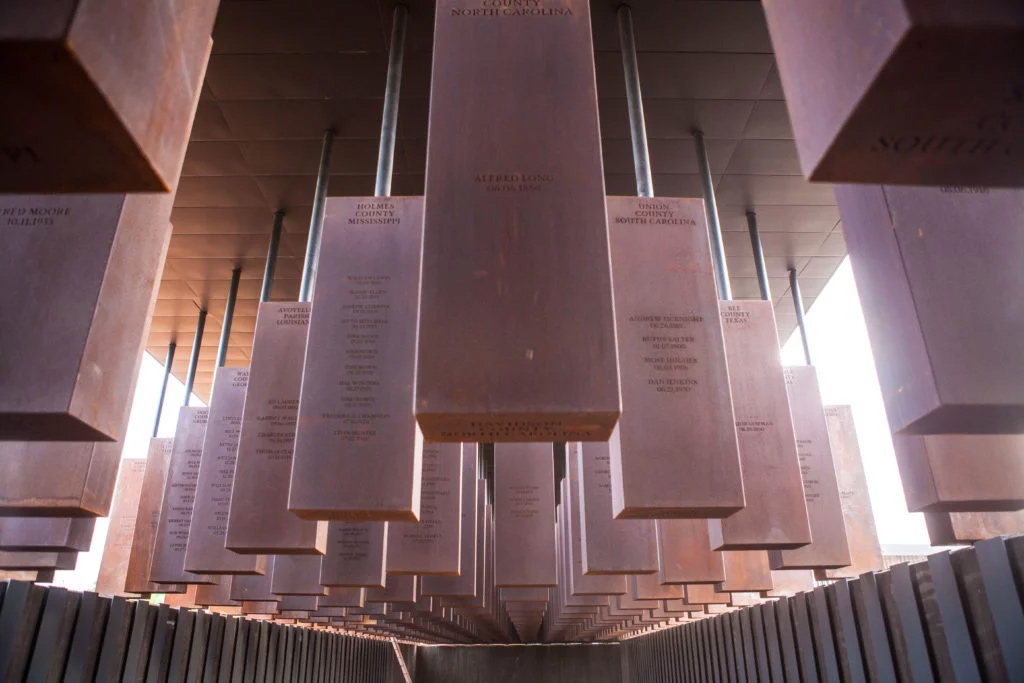On April 26, 2018, the National Memorial for Peace and Justice opened to the public. Installed at 417 Caroline Street in downtown Montgomery, Alabama, it is a counterpoint to The Legacy Museum, which also opened the same day and is located mere feet away at 115 Coosa Street. This memorial, as stated on its site, is “the nation’s first memorial dedicated to the legacy of enslaved Black people, people terrorized by lynching, African Americans humiliated by racial segregation and Jim Crow, and people of color burdened with contemporary presumptions of guilt and police violence.”
The National Memorial for Peace and Justice honors persons in the United States who were victimized by racial terror lynching. The location of the memorial and museum were constructed on six acres, near a market site where Africans and their descendants were sold to be enslaved.
Both institutions were developed from the research and outreach by the Equal Justice Initiative (EJI), a non-profit organization based in Montgomery, Alabama. Founded by MacArthur Fellow Bryan Stevenson, J.D., in 1989, the EJI offers legal representation to those who may not be able to afford quality representation, have been denied a fair trial or have been wrongly convicted. The organization also guarantees the defense of any person in Alabama who is facing the death penalty. Stevenson, a successful attorney, activist and critically-acclaimed author, he is perhaps most popularly-known for his 2014 book and the 2019 film on which it was based, No Mercy: A Story of Justice and Redemption.
The concepts for this memorial and museum were birthed in 2010, when the EJI began investigating the thousands of lynchings of Blacks and accompanying domestic terror unleashed on Black communities in the American South. While many of these attacks were undocumented, more than six million Black people would flee the region for safety, their emigration giving rise to The Great Migration.
The research of the EJI led to the 2015 publication of Lynching in America: Confronting the Legacy of Racial Terror, which detailed racially-terroristic lynchings in twelve states. Post-publication, the EJI continued to research lynching across the United States. Their research led them to visit hundreds of sites, gather data, conduct interviews, collect soil and post markers, “in an effort to reshape the cultural landscape with monuments and memorials that more truthfully and accurately reflect our history.” In all, researchers have documented more than 4, 400 racial terror lynchings that occurred between 1877 and 1950, many of which occurred prior to and just after the beginning of the 20th century.
Stevenson was compelled to create this memorial and museum to honor those persons victimized by a crippled, corrupt criminal justice system and domestic White terrorism. The $20 million complex, utilizing design and sculpture, features a memorial square built in collaboration with MASS Design Group. This non-profit firm has worked in environments, such as Rwanda, that suffered mass trauma and pursued justice and reconciliation. The memorial square contains more than 800 hanging, six-foot corten steel rectangles to symbolize the thousands of those victims of racial terror lynching in the United States, in general, and each county and state, specifically, where this terrorism reigned. These metal monuments, the size and shape of coffins, name where a documented lynching occurred. Engraved on the panels are the lynching victims’ names (or “unknown” if the identity is not known) and dates.
Underneath these hanging monuments are steel columns laid in rows; the columns, which correspond to its host monument, are meant to be temporary. The EJI requests that representatives of each of the counties claim their monument, construct their own memorial to those victimized by racial terror lynching and lead in educational community outreach. By these actions, it is the hope and intent of the EJI that these counties will develop an honest reconciliation, restitution and restoration of justice that has been bereft throughout the United States
Also, at The National Memorial for Peace and Justice are narratives, text and art that further support the vision of Stevenson and the EJI. Visitors to the site can chronologically follow the direction of the memorial, beginning with the sculpture on slavery of Kwame Akoto-Banfo to the sculpture created in honor of the women of the Montgomery Bus Boycott by Dana King. The memorial contains a section dedicated to present issues, ranging from the prison industrial complex to law enforcement abuse and violence, of racial discrimination.
Persons whose work is highlighted at the National Memorial for Peace and Justice include Hank Willis Thomas, Reverend Dr. Martin Luther King, Jr. and Toni Morrison. There is an area, beautifully landscaped, to promote reflection. In this area, there is a space dedicated in memory of activists, including the immensely brilliant, committed and brave, anti-lynching pioneer, Ida B. Wells-Barnett. It is through her tireless investigation that she published her findings in Southern Horrors: Lynch Law in All Its Phases (1892) and The Red Record (1895) that the lynchings of Blacks by Whites were because of economic competition, rather than Blacks had committed any crime.
Since opening to the public, tens of thousands of guests have visited these two sites. Their openings prompted The New York Times to designate them in 2018 as one of the top tour destinations in the world!
Currently, the EJI is in discussion with dozens of communities, including Montgomery, seeking to claim their monuments. Montgomery’s claim is monumental, especially considering its horrific and tragic past of slavery and legacy of racism and discrimination. While some have commented on the harsh and politicized content of the museum, others, including the mayor of Montgomery, Todd Strange, feel this memorial may be the greatest opportunity for America to reconcile with its truth.
